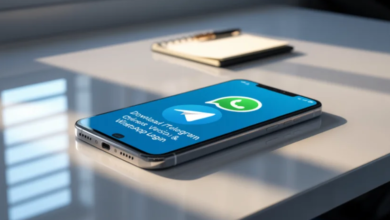The Role of Logo and Visual Identity in Website Design

The logo is often the first visual a visitor sees when they arrive on a website. As such, the logo is the first impression of a brand. In the online world, a logo and its broader visual identity is often the best assets a business has to help visitors identify and remember what it does.
In website design, these visual assets builds trust, communicates brand values, and also aids much of the user experience. You can hire reliable Ontario website design services for the best results.
Why a Logo Deserves Attention
The logo is often the heart of a brand’s image. It is more than just a decoration! A logo is what visitors see first, and anchors their perception. A purposely designed logo, with unique colour, letter combination and visual styling, can communicate an impression of professionalism and purposiveness in seconds. In website design, adding the logo to the header of every page can help visitors feel they are in the right place and set the expectation that they will see that logo or mark consistently whenever they visit the website.
Visual Identity Beyond the Logo
The logo is important, but visual identity goes further than just a logo. Visual identity includes colour palettes, typeface selections, messaging tone, and other graphic features that help define and reinforce what the brand feels like, and incorporates those throughout the website or experience. When visuals and experience are consistent, it creates recognition, whether a visitor encounters the brand in a social feed, on printed materials, or on a website, they have a chance to have that same experience. Consistency builds recognition and trust with the help of Ontario website design services.
Building Credibility and Recognition
A carefully curated visual identity breeds recognition. When a visitor repeatedly sees the same set of visual cues—such as brand colours, fonts, and logo placement—they begin to associate those elements with the company’s values. Over time, this familiarity strengthens trust. Especially in service sectors or local businesses, such consistency signals care, credibility, and reliability.
Guiding Website Design Through Branding
Visual identity is not delivered after the website is built—it shapes it. Decisions about navigation style, page layouts, image treatments, headings, and even button shapes are influenced by branding choices. When logos and visual identity guide design decisions, the site feels unified and purposeful. Rather than a patchwork of elements, the site becomes an extension of the brand itself.
First Impressions Matter in a Few Seconds
The moment someone lands on a page, they make a subconscious decision: Is this website trustworthy? Is this brand professional? A familiar, well-designed logo paired with coherent visual identity reassures the visitor instantly. A confusing or inconsistent visual presentation can create doubt, even before they read a word. In a digital environment where attention is brief, these visual cues are vital.
See also: self loading mixer: The Evolution of Concrete Mixing Technology on Construction Sites
Aligning Visual Identity with Messaging
Visual identity communicates through visuals what written messaging communicates through tone and words. Colours evoke mood; fonts and logo shape set the tone, whether playful or serious. This visual messaging must align with the website copy and brand voice. When visuals and tone reinforce each other, the visitor’s experience becomes coherent, professional, and emotionally resonant.
From Site Design to Other Platforms
A strong visual identity allows a business to carry its look effortlessly across platforms. Whether viewed on a website, Instagram page, printed brochure, or digital advertisement, the colours, style, logo, and fonts remain recognisable. By laying out these rules (often gathered into a style guide), businesses ensure every touchpoint reflects the same brand personality and values.
Refresh and Consistency Over Time
Visual identity is not static. If a business refreshes its logo or slightly adjusts its colour palette, the website design ensures those changes are consistently applied. A small update to the logo can ripple through the site—altering header style, button colour, and image filters. The visual identity framework keeps all these components tied together, resulting in seamless transitions during rebranding or updates.
The Visitor’s Journey and Visual Identity
As visitors navigate from one page to another, visual identity guides them. Consistent layout, familiar branding elements, and predictable navigation encourage exploration. A page header in brand colours, a footer that echoes the logo styling, and button treatments that feel familiar all help the visitor feel grounded. This coherence supports usability, reducing confusion and increasing engagement.
Visual Identity Shapes Emotional Response
Beyond recognition, the visual identity sets an emotional tone. A colour scheme with warm, inviting tones may make a site feel welcoming; cooler, minimalist visuals may evoke professionalism and clarity. Through the strategic use of logo, colours, fonts, and layout, visual identity subtly influences how a visitor feels while using the website. This emotional connection can improve engagement and encourage return visits.
Investing in Design That Works Together
It’s not just about having a good logo—it’s about designing the logo and visual identity so they can work together across digital environments. A logo should look clean at different sizes, including mobile and desktop contexts. Fonts and colours chosen for the logo should carry gracefully into navigation menus, headers, and even button styles. The visual identity becomes the foundation that holds website design together as a whole experience.
Trust Built Through Consistent Visual Presence
When customers land on a site and see branding that is consistent from beginning to end, they form trust. This trust is especially critical for businesses offered locally or regionally. Visual identity built through logo and branding creates a sense of familiarity, professionalism, and care—traits that reassure visitors and strengthen brand perception over time.
Conclusion: Visual Identity as the Backbone of Website Design
A logo is rarely just a graphic on a page. It is the seed that defines how a site looks, feels, and communicates. A visual identity built from that seed ensures that the entire website—from logo placement to colour schemes and typography—supports a cohesive experience. By aligning logo design with web layout, messaging, and cross-channel presentation, businesses create websites that not only look good but feel trustworthy and memorable. Every visual element on a website tells a story about the brand; when done with consistency and intention, the result is a unified digital presence that visitors recognise, connect with, and remember.



